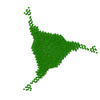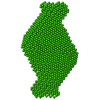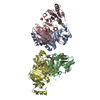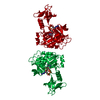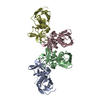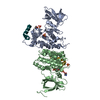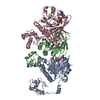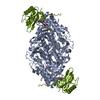+ Open data
Open data
- Basic information
Basic information
| Entry | Database: SASBDB / ID: SASDC67 |
|---|---|
 Sample Sample | SaPIbov1 pathogenicity island repressor
|
| Function / homology | Helix-turn-helix / Helix-turn-helix XRE-family like proteins / Cro/C1-type HTH domain profile. / Cro/C1-type helix-turn-helix domain / Lambda repressor-like, DNA-binding domain superfamily / DNA binding / Stl Function and homology information Function and homology information |
| Biological species |  |
 Citation Citation |  Date: 2018 Mar 12 Date: 2018 Mar 12Title: Structural model of human dUTPase in complex with a novel proteinaceous inhibitor Authors: Nyíri K / Mertens H / Tihanyi B / Nagy G / Kőhegyi B / Matejka J / Harris M / Szabó J / Papp-Kádár V / Németh-Pongrácz V / Ozohanics O / Vékey K / Svergun D / Borysik A |
 Contact author Contact author |
|
- Structure visualization
Structure visualization
| Structure viewer | Molecule:  Molmil Molmil Jmol/JSmol Jmol/JSmol |
|---|
- Downloads & links
Downloads & links
-Data source
| SASBDB page |  SASDC67 SASDC67 |
|---|
-Related structure data
| Related structure data | C: citing same article ( |
|---|---|
| Similar structure data |
- External links
External links
| Related items in Molecule of the Month |
|---|
-Models
| Model #1487 |  Type: atomic / Software: (2.0) / Radius of dummy atoms: 1.90 A / Symmetry: P2 Comment: server address: http://www.sbg.bio.ic.ac.uk/phyre2/html/page.cgi?id=index Chi-square value: 0.622  Search similar-shape structures of this assembly by Omokage search (details) Search similar-shape structures of this assembly by Omokage search (details) |
|---|---|
| Model #1488 |  Type: dummy / Software: (2.9.0) / Radius of dummy atoms: 2.20 A / Symmetry: P2 / Chi-square value: 0.605  Search similar-shape structures of this assembly by Omokage search (details) Search similar-shape structures of this assembly by Omokage search (details) |
- Sample
Sample
 Sample Sample | Name: SaPIbov1 pathogenicity island repressor / Dry vol: 38738 / Specimen concentration: 0.20-0.90 / Concentration method: A280 |
|---|---|
| Buffer | Name: 50 mM HEPES 300 mM NaCl 5 mM MgCl2 / pH: 7.5 / Comment: Buffer B |
| Entity #776 | Name: Stl / Type: protein / Description: SaPIbov1 pathogenicity island repressor / Formula weight: 32.016 / Num. of mol.: 2 / Source: Staphylococcus aureus / References: UniProt: E2FZP6 Sequence: GSPEFSMEGA GQMAELPTHY GTIIKTLRKY MKLTQSKLSE RTGFSQNTIS NHENGNRNIG VNEIEIYGKG LGIPSYILHR ISDEFKEKGY SPTLNDFGKF DKMYSYVNKA YYNDGDIYYS SYDLYDETIK LLELLKESKI NVNDIDYDYV LKLYKQILST DTEKSIINYE ...Sequence: GSPEFSMEGA GQMAELPTHY GTIIKTLRKY MKLTQSKLSE RTGFSQNTIS NHENGNRNIG VNEIEIYGKG LGIPSYILHR ISDEFKEKGY SPTLNDFGKF DKMYSYVNKA YYNDGDIYYS SYDLYDETIK LLELLKESKI NVNDIDYDYV LKLYKQILST DTEKSIINYE TLANTRKSSD KKREVTIEEI GEFHEKYLKL LFTNLETHND RKKALAEIEK LKEESIYLGE KLRLVPNHHY DAIKGKPMYK LYLYEYPDRL EHQKKIILEK DTN |
-Experimental information
| Beam | Instrument name: PETRA III EMBL P12 / City: Hamburg / 国: Germany  / Type of source: X-ray synchrotron / Wavelength: 0.124 Å / Dist. spec. to detc.: 3.1 mm / Type of source: X-ray synchrotron / Wavelength: 0.124 Å / Dist. spec. to detc.: 3.1 mm | |||||||||||||||||||||||||||||||||||||||||||||||||||||||||
|---|---|---|---|---|---|---|---|---|---|---|---|---|---|---|---|---|---|---|---|---|---|---|---|---|---|---|---|---|---|---|---|---|---|---|---|---|---|---|---|---|---|---|---|---|---|---|---|---|---|---|---|---|---|---|---|---|---|---|
| Detector | Name: Pilatus 2M | |||||||||||||||||||||||||||||||||||||||||||||||||||||||||
| Scan |
| |||||||||||||||||||||||||||||||||||||||||||||||||||||||||
| Distance distribution function P(R) |
| |||||||||||||||||||||||||||||||||||||||||||||||||||||||||
| Result |
|
 Movie
Movie Controller
Controller



